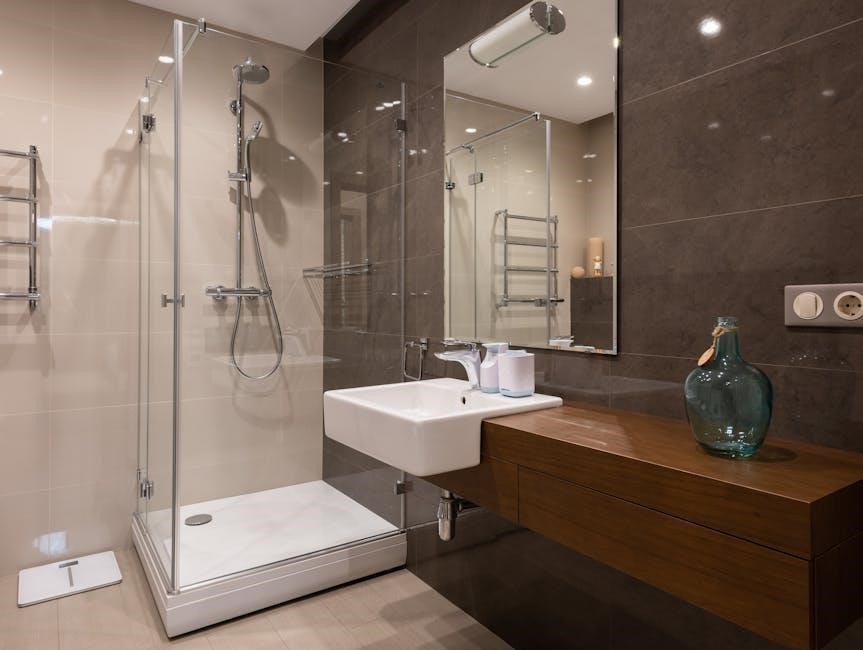Understanding bathroom plumbing rough-in dimensions is essential for ensuring proper fixture installation and compliance with safety standards. These measurements guide pipe placement, supply lines, and drain positioning, guaranteeing efficient water flow and system functionality. Accurate rough-in dimensions prevent costly repairs and ensure long-term reliability, making them a critical step in bathroom plumbing projects. These standards vary by fixture type and local regulations, emphasizing the need for precise planning and execution during the rough-in phase.
What Are Bathroom Plumbing Rough-In Dimensions?
Bathroom plumbing rough-in dimensions refer to the standardized measurements for installing pipes, fixtures, and drainage systems during the initial stages of construction. These dimensions ensure proper placement of supply lines, drainpipes, and ventilation systems, aligning with local building codes and safety standards. They are crucial for the efficient functioning of bathroom fixtures such as toilets, sinks, showers, and tubs. Rough-in dimensions typically include the height and distance of supply lines, the slope of drainpipes, and the positioning of ventilation pipes. Adhering to these measurements guarantees optimal water flow, prevents leaks, and ensures compliance with regulatory requirements. Accurate rough-in dimensions are essential for a successful plumbing installation, avoiding costly repairs and ensuring long-term reliability.

Standard Dimensions for Common Bathroom Fixtures
This section outlines the essential measurements for installing bathroom fixtures, ensuring they fit and function properly. Key dimensions include toilet rough-in (10-14 inches), sink supply lines (31-36 inches high), and shower drain placement. These standards ensure compliance with local codes and manufacturer specifications, guaranteeing efficient installation and long-term performance.
Toilet Rough-In Dimensions
Toilet rough-in dimensions are critical for proper installation and functionality. The standard toilet rough-in is 12 inches, measured from the wall to the center of the drain pipe. However, dimensions can vary slightly, with common options being 10 inches or 14 inches, depending on the toilet model and local plumbing codes. The supply line for the toilet is typically positioned 8.25 inches above the floor, while the drain pipe center should align with the toilet’s outlet. Accurate measurements ensure the toilet fits securely and functions without leaks. It’s important to double-check these dimensions with the manufacturer’s specifications and local building codes to avoid installation issues. Proper alignment and spacing are key to a successful and durable installation.
Sink and Lavatory Rough-In Dimensions
Sink and lavatory rough-in dimensions are crucial for proper water supply and drainage functionality. The standard drain rough-in height for bathroom sinks is typically 18-20 inches above the floor, ensuring proper drainage flow. Supply lines are usually positioned 2-3 inches above the drain line, with horizontal supply lines placed 4 inches from the wall. These measurements ensure the sink is installed at a comfortable height and meets local plumbing codes. Factors like counter height and fixture type can influence these dimensions, so it’s essential to verify measurements with the manufacturer’s specifications. Proper alignment of supply and drain lines ensures efficient water flow and prevents future plumbing issues. Always consult local building codes and manufacturer guidelines for precise installation requirements.
Shower and Tub Rough-In Dimensions
Shower and tub rough-in dimensions are critical for proper drainage and water flow. The drain line for showers and tubs is typically positioned 12-18 inches above the floor, ensuring a slope of 1/4 inch per foot for proper drainage. Faucet supply lines are usually placed 48-52 inches above the floor to align with standard faucet heights. The P-trap for tubs should be installed 12-18 inches from the floor, while shower drains may vary based on design. These measurements ensure water flows correctly and prevents clogging. Local building codes and manufacturer specifications may require adjustments, so it’s essential to verify requirements before installation. Proper alignment of drain and supply lines ensures long-term functionality and prevents costly repairs. Always consult plumbing diagrams for precise measurements tailored to your specific fixtures.

Key Measurements for Plumbing Rough-In
Accurate measurements ensure proper installation and functionality of bathroom plumbing systems. Standard dimensions for supply lines, drains, and vents must align with local codes and fixture requirements to guarantee efficiency and safety. Precise calculations prevent future issues, making them a cornerstone of successful plumbing projects. Always verify measurements against manufacturer specifications and regulatory guidelines for optimal results. Proper planning and execution during the rough-in phase are essential for long-term system reliability and performance. This stage sets the foundation for all subsequent plumbing work, emphasizing the importance of attention to detail. Measurements must be carefully recorded and followed to avoid costly corrections later. Compliance with established standards ensures both functionality and safety in bathroom plumbing systems.
Supply Line Heights and Distances
Supply line heights and distances are critical for proper water delivery to bathroom fixtures. For toilets, supply lines are typically installed 8 1/4 inches above the floor, ensuring adequate clearance and alignment with the toilet tank. Sink supply lines are usually positioned 31 inches above the floor, matching standard countertop heights. Horizontal distances vary by fixture, with sink supply lines often placed 6 inches from the wall to accommodate faucet mounting. These measurements ensure compatibility with common fixture designs and compliance with plumbing codes. Proper alignment prevents water hammer and ensures smooth operation. Always verify local regulations and manufacturer specifications for precise requirements. Accurate supply line placement is vital for functionality and longevity of the plumbing system.
Drain Pipe Placement and Slope
Accurate drain pipe placement and slope are essential for proper drainage and to prevent clogs. The standard slope for drain pipes is typically 1/4 inch per foot, ensuring gravity-assisted flow. For toilets, the drain pipe is usually centered 12 inches from the wall, while sink drains are placed 18-20 inches above the floor. Proper alignment with fixtures is critical to avoid siphoning and backups. Local codes may vary, so always verify requirements. Incorrect slope or placement can lead to poor drainage and increased maintenance. Precise installation ensures efficient wastewater removal and prevents plumbing issues. Always follow manufacturer and regulatory guidelines for optimal performance and compliance. Proper drain pipe placement and slope are foundational to a reliable plumbing system.
Ventilation Pipe Requirements
Ventilation pipes are critical for maintaining proper air pressure and preventing sewer gases from entering the bathroom. These pipes typically range from 1.5 to 4 inches in diameter, depending on the fixture type and local codes. Proper placement ensures efficient drainage and prevents siphonage. The ventilation system must terminate above the roof or at a safe distance from windows to avoid re-entry of gases. Local building codes often dictate specific installation requirements. Correct sizing and positioning of ventilation pipes are essential for system efficiency and safety. Always consult local regulations and manufacturer guidelines to ensure compliance. Proper ventilation installation prevents plumbing issues and ensures a healthy indoor environment. Accurate rough-in measurements for ventilation pipes are vital for long-term functionality and safety. These requirements vary by jurisdiction, so precise planning is necessary.

Factors Influencing Bathroom Plumbing Layout
Local building codes, bathroom design preferences, and fixture-specific requirements significantly influence plumbing layouts. These factors ensure compliance, functionality, and aesthetic appeal, guiding pipe placement and fixture positioning.
Local Building Codes and Regulations
Local building codes and regulations play a crucial role in determining bathroom plumbing rough-in dimensions. These codes ensure installations meet safety and structural standards, preventing potential hazards. Compliance with regulations like the International Residential Code and local ordinances is mandatory. For instance, specific requirements for pipe sizing, ventilation systems, and fixture placement must be adhered to. Failure to comply can result in failed inspections and costly rework. Additionally, codes often dictate minimum clearances and accessibility standards, influencing the overall layout. Staying informed about local regulations is essential for contractors and homeowners to avoid legal issues and ensure a safe, functional bathroom space. These guidelines vary by region, so consulting local authorities is always recommended.
Bathroom Design and Layout Preferences
Bathroom design and layout preferences significantly influence plumbing rough-in dimensions. While functionality is key, aesthetics and user comfort also play roles. For example, a modern bathroom might prioritize a wall-mounted toilet or a freestanding tub, requiring specific rough-in measurements. The placement of fixtures such as sinks, showers, and bathtubs depends on the desired layout. Accessibility and ergonomics are also considered, with factors like counter height and fixture positioning tailored to user needs. Design preferences may dictate custom dimensions, but they must still align with local building codes. Balancing style and practicality ensures a bathroom that is both visually appealing and functional. Advanced planning is essential to integrate design elements seamlessly with plumbing requirements, avoiding future adjustments and ensuring a smooth installation process.
Fixture Type and Brand-Specific Requirements
Fixture type and brand-specific requirements significantly impact bathroom plumbing rough-in dimensions. Different fixtures, such as toilets, sinks, and showers, have unique installation needs. For instance, a wall-mounted toilet may require different rough-in measurements compared to a standard floor-mounted model. Additionally, certain brands, like Kohler or Toto, may specify particular dimensions for their products. These requirements ensure proper fitment and functionality. It’s crucial to consult the manufacturer’s guidelines to avoid installation issues. Brand-specific instructions often include precise measurements for supply lines, drain placements, and mounting heights. Adhering to these specifications ensures compatibility and optimal performance. Always verify the exact requirements for the chosen fixtures to guarantee a flawless plumbing setup. Custom or luxury fixtures may demand even more precise measurements, emphasizing the need for careful planning.

Importance of Accurate Rough-In Measurements
Accurate rough-in measurements ensure proper fixture installation, prevent leaks, and maintain water efficiency. They also guarantee compliance with local building codes and minimize costly future repairs; Precision in measurements is key to avoiding common plumbing issues and ensuring long-term system reliability. Properly aligned pipes and drains prevent water damage and promote optimal performance. Attention to detail during the rough-in phase saves time and money by reducing the need for adjustments or repairs later. It also ensures safety by meeting standardized plumbing practices. Accuracy is non-negotiable for a functional and durable plumbing system.
Preventing Plumbing Issues and Repairs
Accurate rough-in measurements are critical for preventing plumbing issues and costly repairs. Proper pipe alignment and sizing ensure water flows smoothly, reducing the risk of leaks and blockages. Incorrect measurements can lead to poor drainage, backups, and water damage. For example, a toilet supply line installed too low or high can cause flushing problems, while a drain pipe placed at the wrong slope may lead to clogs. By adhering to standard dimensions, plumbers can avoid common issues like uneven water pressure or improper venting, which can disrupt system performance. Attention to detail during the rough-in phase ensures fixtures function as intended, minimizing the need for future repairs and maintaining a reliable plumbing system.
Ensuring Compliance with Safety Standards
Accurate bathroom plumbing rough-in dimensions are vital for ensuring compliance with safety standards. Proper pipe placement and sizing prevent hazards like water contamination or scalding. Local building codes dictate specific requirements to ensure safety, such as correct water supply line heights and drain slopes. For example, supply lines must be installed at precise elevations to maintain water pressure and temperature control. Drain pipes must slope correctly to prevent siphoning and ensure proper ventilation. Fixture-specific requirements, such as those for toilets or showers, also play a role in safety. Compliance with these standards prevents potential hazards and ensures a reliable, hazard-free plumbing system. Adhering to these guidelines is essential for protecting both the structure and its occupants.
Accurate bathroom plumbing rough-in dimensions ensure proper installation, functionality, and safety. Adhering to local codes and manufacturer specifications guarantees compliance and long-term reliability. This stage is foundational for a successful plumbing system.
Final Tips for Successful Bathroom Plumbing Rough-In
For a successful bathroom plumbing rough-in, ensure all measurements align with local codes and manufacturer specifications. Double-check supply line heights, drain placements, and ventilation requirements. Use a level to confirm proper pipe slopes and avoid common issues like clogs or water pressure problems. Consult detailed diagrams or blueprints for precise fixture positioning. Leave adequate space for future adjustments and consider upgrading to universal fixtures for flexibility. Test all connections before finishing the installation to identify and fix potential leaks or misalignments. Document your work for reference during inspections or future renovations. By following these tips, you’ll achieve a durable, efficient, and compliant plumbing system.
